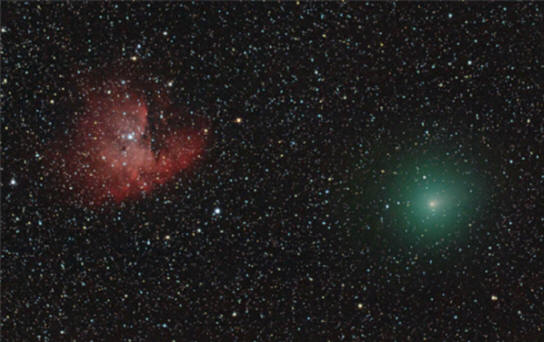|

Comet 103P/Hartley 2 (right) and NGC
281, the PacMan Nebula. Credit: Mike
Broussard
The EPOXI Mission
Nov
02, 2010
NASA scientists hope this new
mission will help them learn more
about what comets are but admit that
they might find "more puzzles."
The Stardust mission collected dust
particles from the coma of comet
Wild 2 and then sent them to Earth.
The system worked perfectly,
scooping up fine bits of rock and
trapping them for their return
journey on January 15, 2006.
Mission specialists were shocked
to discover minerals in the sample
that form only at extremely high
temperatures. Since conventional
theories describe comets as "dirty
snowballs," how could an object that
was supposed to be a denizen of the
Solar System's most remote region, a
"leftover" from the primal nebular
cloud, exhibit a crystalline
structure that could only be forged
in a furnace of fire?
Other comets have demonstrated
anomalies in their characteristics
and behavior. Years after Hale-Bopp
made its appearance in Earth's night
sky, when it was far past Jupiter's
orbit, it displayed an ion tail,
bright jets, and a glowing coma. The
"dirty snowball" theory cannot
account for such activity at
distances where radiant emissions
from the Sun will not melt ice.
Logically, if the Sun caused
Hale-Bopp to discharge at that
distance, all of Jupiter's moons
would be bone dry and appear more
like our own moon than like the
frozen bodies that they are. If the
Sun was not responsible for
Hale-Bopp's display, then what
provided the energy for its
explosive eruptions?
Comet Linear actually
blew apart when it was over 100
million kilometers from the Sun and
not when it passed by during
perihelion. The strange fact is that
the majority of cometary disruptions
take place when they are far from
the Sun.
Sun-grazer comets do not
break apart despite sometimes coming
within 50,000 kilometers of the
Sun's photosphere.
In 2001, Deep Space 1 found that
comet Borrelly was hot
and dry instead of cold and wet.
Tempel 1 was also thought
to conform to conventional comet
theory, but it looked more like an
asteroid, with a large crater and
cliffs, than a snowball venting
steam. Shoemaker-Levy 9 blew up when
it crossed Jupiter's powerful
magnetosphere, but the broken pieces
did not expel any water vapor.
The Tempel 1 impact mission has
been renamed
EPOXI (Extrasolar Planet
Observation and Characterization
combined with Deep Impact eXtended
Investigation) and is set to explore
comet 103P/Hartley 2. The green
color of Hartley 2 is said to come
from the release of cyanogen, but
another possibility is that it is
due to diatomic carbon. Since
cometary phenomena are primarily
electrical in nature, the presence
of diatomic carbon would not be a
surprise to Electric Universe
proponents.
It can be surmised that when
water or hydroxyl compounds are
found in cometary comas, they are
created there. Ionized oxygen from
the comet nucleus reacts with
hydrogen ions streaming out from the
Sun. No "jets" of water vapor spew
from comets, and no icy plains have
ever been observed. It is electric
effects that are seenódischarges and
arcs form the comet phenomena.
Electric arcs could easily form
the diatomic carbon seen in Hartley
2's coma, since it is most readily
created when a powerful electric
current is passed through a gap
between two carbon rods. Diatomic
carbon does not last long, however.
It quickly stabilizes into graphite,
diamond, or other more exotic forms.
While in its ground state, it may
combine with hydrogen to form
acetylene, with nitrogen to form
cyanogen, or with oxygen to form
carbon dioxide. It is the emission
spectra of diatomic carbon that is
most often seen in faint comets.
Comets have nothing to do with a
primordial nebular cloud of cold gas
and dust that is said to have
collapsed into our Solar System.
Rather, comets and their asteroid
sisters are most likely newcomers to
the Sun's family, and might have
been blasted out of larger bodies by
powerful electric discharges in the
recent past. They are not
"snowballs" or blobs of muddy slush,
they are solid, rocky, cratered,
electrically charged objects.
Stephen Smith
Editor's note: For a more
extensive review of the EPOXI
mission encounter with 103P/Hartley
2, see Wal Thornhill's
Holoscience.com article
Deep Impact 2.
|







